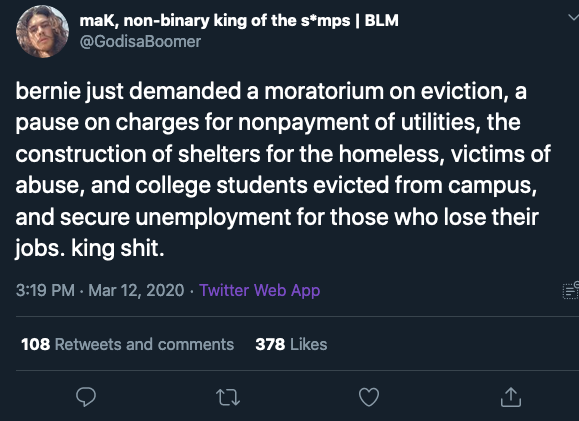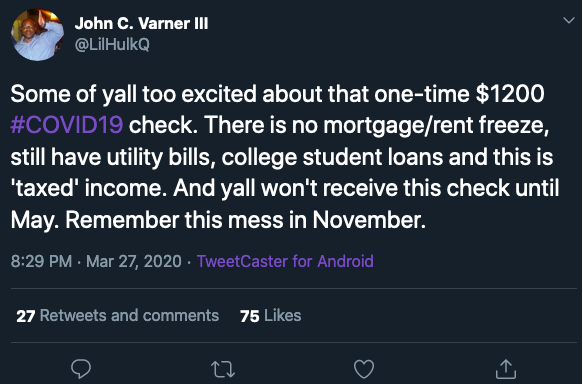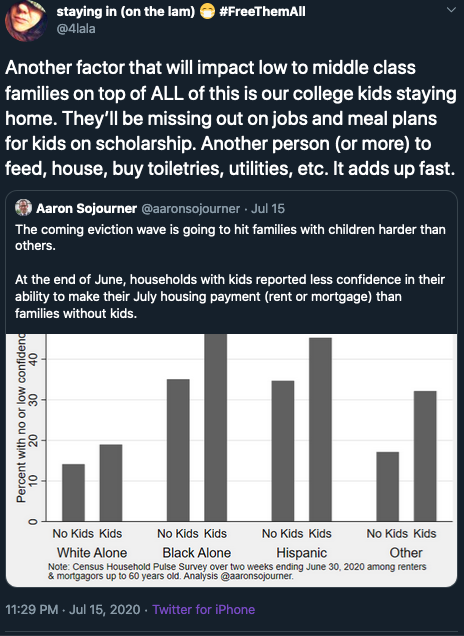Leone, B. "Analyzing vulnerabilities experienced by college students as recounted on Twitter," in The Energy Vulnerability Project, Platform for Experimental and Collaborative Ethnography. (Original, 20 July 2020).
What kind of vulnerabilities are experienced by college students?
Has the COVID-19 pandemic worsened precarities experienced by college students?
How have students reacted to the COVID-19 pandemic?
How are students coping with the current pandemic?
What are students’ opinions on the stimulus package excluding 18-24 year-olds?







One thing to note in the data collection is that social media’s personalized results feature could have potentially skewed the tweets herein collected. Briefly, social media tend to generate algorithms based on social media use; even when using the search bar, results are still modeled using an algorithm developed based on the accounts' likes and retweets; in this case, my account. That said, even when searching for keywords, the results collected could be specifically modeled based on the account activity that is associated with my Twitter profile. Nevertheless, to briefly describe the tweet collection process, the tweets here shown were collected in two separate rounds, the first round being at the ‘release’ of the CARES Act, when 18-25 year-olds were initially excluded from the stimulus check; the second round of collection happened in mid-July, at the time of record-high infection rates in the United States and the continued economic disarray. Searches were made using the following keywords in both rounds: “bills + college and “utility + college”. All the relevant tweets for each search were archived in both link and image form. Following the complete collection, the second round of collection also saw a categorization of these tweets. The tweets were categorized based on time and theme, meaning the tweets collected in April were considered thematically relevant in April and those collected in July were considered thematically pertinent to July. All of the tweets collected explicitly or implicitly refer to multi-level socioeconomic and sociopolitical inequalities faced by college students, as well as their families.
Several empirical studies highlight how policies and measures of energy vulnerability do not necessarily take college students into consideration (Morris & Genovese, 2018). Other studies, like the ones from Rugg et al. (2002) and Kemp (2001) suggest students are able to adapt to emergent situations but, overall, have to sacrifice the possibility of securing quality housing in favor of affordable prices. Students do not necessarily consider themselves energy vulnerable, which calls for a need to investigate the nexus between the 'studentification' of energy vulnerability and living in sub-optimal conditions (Morris & Genovese, 2018).
The conditions of energy vulnerability in young adults have also been aggravated by their exclusion from receiving the stimulus check under the CARES Act (2020). That said, these new precarious conditions can also be analyzed through the conceptualizations of energy precarity in young adults as presented by Petrova (2018). According to the scholar's empirical study, young adults who rent privately are faced with higher burdens than other populations (Petrova, 2018). In an examination of young adults' experiences, Petrova (2018) also analyzes the spaces in which energy deprivation is created and reproduced, which again is given little attention.
All of the foregoing theoretical basis serves to inform investigations into complaints made on the Twitter platform by college students, including at the initial CARES Act release when 18-24 year-olds were excluded from the CARES Act (2020) stimulus check. Considerations made in this investigation highlight college students' unique vulnerability as a population and how said position is reinforced and aggravated by the COVID-19 pandemic and by being excluded from the stimulus package. Morris and Genovese (2018) and Petrova (2018)'s studies help frame the thematics collected through the tweets, situating both the understudied phenomenon of university students and young adults' energy vulnerability [or precarity, as defined by Petrova (2018)].
With the rising popularity of social media research, this brief investigation was modeled on the archetype ideated by scholars such as Ahmed (2019), Ahmed et al. (2019), and Ngai et al. (2015). Ahmed (2019)'s blog post presents a table with methods to be used. According to Ahmed (2019)'s categorization, the investigation here conducted was modeled on a thematic approach. In much a similar way as the one performed by Ahmed et al. (2019)'s analyses of Twitter discourses on the swine flu, this investigation considered discussions of vulnerabilities by college students, notably as students were excluded from the stimulus check under the CARES Act (2020). While the data set of this investigation is only a fraction of the tweets collected, and less than data collected by Ahmed et al. (2019) and the 46 empirical studies analyzed by Ngai et al. (2015), similar approaches were taken to collect and analyze data.
To see if there are connections between COVID-19, college students, and energy vulnerability I decided to see what the convergence of the three preceding conditions was like on the Twitter community. I did this by going on Twitter and searching for ‘utility + college” in the search bar. Once results originated I scrolled all the way back to the beginning of March and bookmarked relevant tweets as I moved through them. Once I believed I had exhausted the tweets from this search, I moved forward to searching ‘bills and college’ to see if different results came up, and I proceeded to go all the way back to March and bookmarked relevant tweets as I went along. One common hashtag that originated was #JeffreyStar, when the social media and fashion figure was randomly handing out money to those who were struggling and added his tag to their tweets. I proceeded to do the same for the other keyword searches, at two different time frames. For these tweets, it is also important to look at the replies. Initially, I collected the tweets and stored them in a document for later analysis. Once all data was collected, they were categorized based on the kind of theme they evoked and grouped together as such. The two rounds of data collection were classified separately, as they evoked similar but distinct thematics.
Tweets collected in April (Total: 52)
Tweets Collected in July (Total: 26)
Speaking with regards to the first round of tweets collected, the general ‘trend’ in the tweets was outrage at the exclusion of 18-24 year-olds, who tend to be struggling college students, from the stimulus package included under the CARES Act (2020). That said, tweets collected in what could be defined as Round 1 were categorized as follows: 1) Tweets calling for the college to be a public institution; 2) tweets referencing vulnerable people, evictions, and shut-offs; 3) social inequalities of generational poverty and debt; 4) difficulties experienced as college students; 5) stimulus for college students; 6) being dependent and responsible for bills at the same time; 7) going back to normal. The majority of the tweets collected, accounting for 28.8% of the tweets collected, referenced the difficulties experienced by college students, specifically situated in the context of being excluded from the stimulus package. The second most common thematic tweets were the ones specifically referencing the stimulus. These tweets generally demonstrated the greatest outrage at not receiving the stimulus. The third most popular category was tweets that referenced vulnerable populations, evictions, and utility shutoffs. Overall, all of the tweets in this category also distinguish themselves from the tweets collected in July given they voice outrage and dissatisfaction with the immediate responses to the pandemic or lack thereof. Overall, the tweets collected in April have subtle tones of unfamiliarity with the situation which could arguably be said to be a population-wide unfamiliarity to a novel infection and situation. That said, even initial tweets voicing concerns over the pandemic reveal widespread social inequalities, particularly tweets that reference “college students that’s [that are] struggling[L1] ”, of “broke college[L2] student[s]”, and who “pay all [their] own[L3] bills [with] no stimulus check”, really voicing how “this whole stimulus package really screwed college students over[L4] ”.
For the second round of data collection, there were relatively fewer tweets collected than the ones collected in April under those same keywords. In fact, the tweets collected for the second round were 26 compared to 52 of the first round. In any case, for the second round of collection, the tweets were subdivided into the following thematic categories: 1) paying for unused services; 2) added burden of students returning home; 3) burden of living and studying expenses; 4) designating essential workers; 5) outsider status; 6) sweep of socioeconomic reform. The most common thematic tweet in the second round was tweeted referencing the burden experienced in relation to costs of living or studying, or both (42.3%). This was followed by a tie between paying for unused services (19.3%) and calling for a sweep in socioeconomic reform (19.3%). One of the first observations to take into consideration for the second round of tweet collection is the ‘maturation’ of the topics discussed as related to the pandemic and financial assistance provided by the government. There also seems to be a more explicit denunciation of the intersectional nature of burdens faced by college students, as particularly situated and aggravated by COVID-19. In fact, a tweet asked whether “you should still be expected to pay utilities even tho[ugh] you’re[L5] not utilizing them”, shouldered by a tweet referencing the added burden on “low to middle class families […having] college kids staying home[L6] ”, and others yet voicing their concern on having to pay “college utilities[L7] since march” even though they had used them since then. Overall, this data could be used as digital ethnographic data (if accompanied by additional investigations) to further inform the nature of burden experienced by families during the coronavirus pandemic and entrenched economic crisis.
[L1]@balla1981 - twitter
[L2]@AmandaH5241
[L3]@KylieButters72
[L4]@Hannah_mae12
[L5]@cecikaufman
[L6]@4lala
[L7]@Samiksh62505798
Overall, the data here collected shoulders the claims made by Petrova (2018) and Morris and Genovese (2018), whereby university students and young adults’ unique, vulnerable situations are ignored or overlooked. That said, students and young adults’ tweets truly voice their dismay at being ignored in their needs for assistance from the stimulus package. Further, this set of the population is uniquely vulnerable in their concurrent position as dependent filers - needed to secure health insurance from their parents - whilst being temporary workers to cover college and living expenses and having the added burdens of college debt, bills, and so forth. This brief investigation reinforces empirical data already published by scholars like Bouzarovski et al. (2013), Petrova (2018), and Morris and Genovese (2018), whereby the spatial, socioeconomic, and energy vulnerabilities are all reproduced and uniquely experienced by young adults who face precarity without necessarily qualifying for assistance.
As such, future investigations should take into consideration limitations in existing measures of energy vulnerability, particularly related to the experiences of college students and college-aged young adults. Additionally, more information should be gathered on how extensively young adults consider themselves to be energy vulnerable when they voice their vulnerabilities on Twitter. However, future investigations and policy advocates should concern themselves with analyzing how current energy vulnerability and energy assistance policies may not necessarily consider the nature of vulnerability that is experienced by college-aged young adults and the nature of their employment, which may be temporary or underpaid and overworked.
Ahmed, W. (2019). "Using Twitter as a data source: an overview of social media research tools." LSE Impact Blog. Retrieved from https://blogs.lse.ac.uk/impactofsocialsciences/2019/06/18/using-twitter-...
Ahmed, W., Bath, P. A., Sbaffi, L., and Demartini, G. (2019). Novel insights into views towards H1N1 during the 2009 Pandemic: a thematic analysis of Twitter data. Health Information and Libraries Journal, 36(1), 60-72. https://doi-org.ezproxy2.library.drexel.edu/10.1111/hir.12247
Bouzarovski S, Petrova S, Kitching M and Baldwick J (2013) Precarious domesticities: Energy vulnerability among urban young adults. In Bickerstaff K, Walker G and Bulkeley H (eds) Energy Justice in a Changing Climate: Social Equity and Low-Carbon Energy. London: Zed Books, 30-45
Morris, J. and Genovese, A. (2018). An empirical investigation into students' experience of fuel poverty. Energy Policy, 120, 228-237. https://doi.org/10.1016/j.enpol.2018.05.032
Ngai, E. W. T., Tao, S.S.C., Moon, K.K.L. (2015). Social media research: Theories, constructs, and conceptual frameworks. International Journal of Information Management, 35(1), 33-44. https://doi-org.ezproxy2.library.drexel.edu/10.1016/j.ijinfomgt.2014.09.004
Petrova, S. (2018). Encountering energy precarity: Geographies of fuel poverty among young adults in the UK. Transactions of the Institute of British Geographers, 43, 17-30. DOI: 10.1111/tran.12196